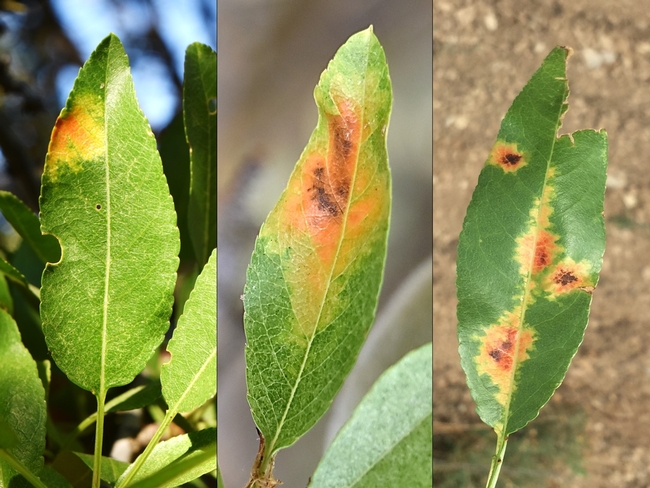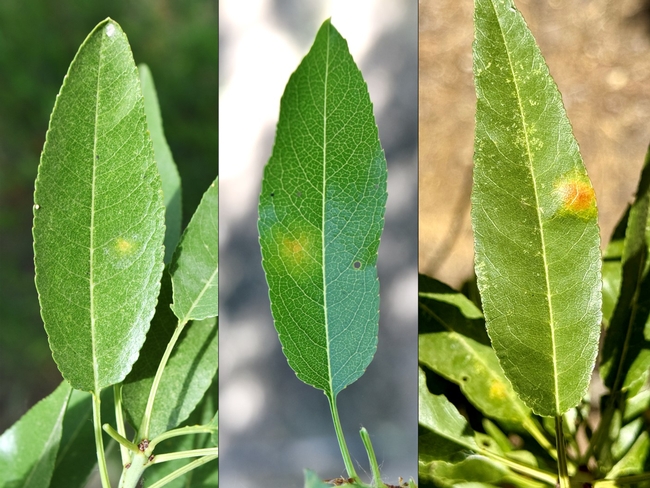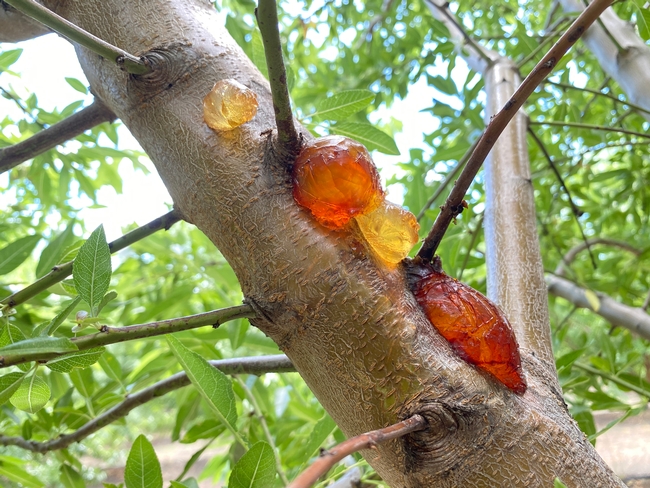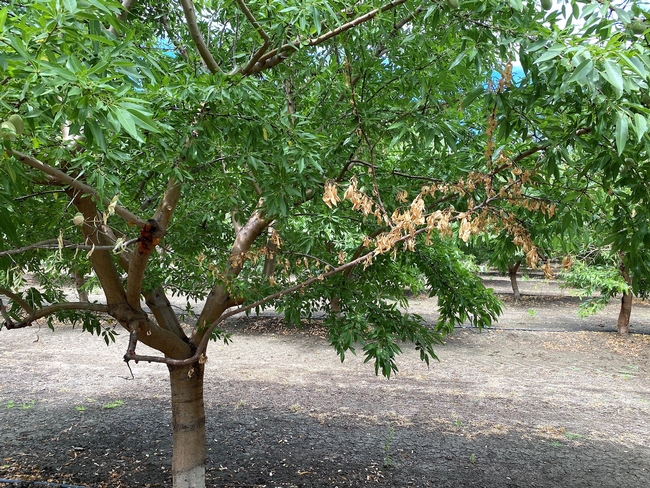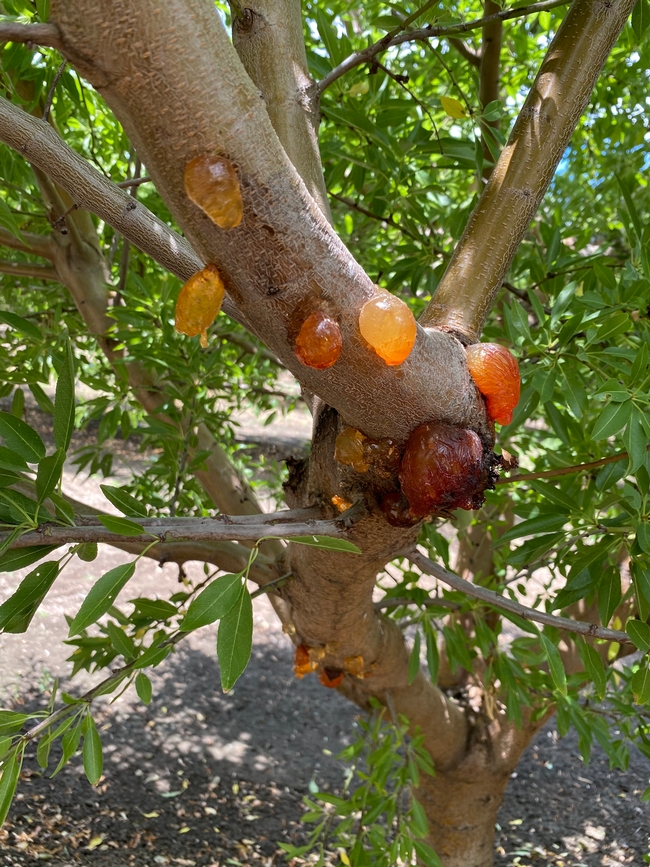
Posts Tagged: almond
Almond crop yields threatened by disease new to California
Detection of fungus causing red leaf blotch spurs call for grower vigilance
Symptoms of red leaf blotch (RLB), a plant disease caused by the fungus Polystigma amygdalinum, have been observed for the first time in California across the Northern San Joaquin Valley.
Molecular DNA testing by the laboratory of Florent Trouillas, University of California Cooperative Extension fruit and nut crop pathology specialist, has detected P. amygdalinum. Pest identification was confirmed by the California Department of Food and Agriculture and U.S. Department of Agriculture.
The disease, named for the characteristic orange-to-dark red blotches that appear on infected leaves, is typically nonlethal for trees but has been a long-standing problem for almond-growing regions across the Mediterranean. Causing trees to lose their leaves prematurely, the fungal pathogen can significantly diminish crop yields in the current year and the next.
“It is one of the most severe diseases of almonds for Spain and the Middle East,” said Trouillas, an associate professor in the UC Davis Department of Plant Pathology. He recently co-authored an explanatory article on the UCCE San Joaquin Valley Trees and Vines blog.
With symptomatic trees seen in multiple orchards across Madera, Merced, San Joaquin and Stanislaus counties, Trouillas said RLB is already “somewhat widespread.”
“From the first observations so far, it seems like it affects some of the most-planted cultivars, like Nonpareil and Monterey,” he added. “We've observed it in a diversity of cultivars already.”
UC Cooperative Extension specialist urges taking preventive measures
According to Trouillas, RLB caused by P. amygdalinum is “highly specific” to almond trees, and generally only affects their leaves. Infection typically happens at petal fall, when small leaflets are first emerging and most susceptible to disease. After the pathogen's latent period of about 35 to 40 days, the first symptoms appear – small, pale-yellow spots on both sides of the leaves.
Those blotches become yellow-orange and then reddish-brown in the advanced stages of the disease during June and July. Now, with RLB symptoms becoming more prominent, Trouillas and UC Cooperative Extension advisors across the Central Valley have seen an uptick in calls.
“PCAs [pest control advisers] have been confused because they've never seen anything like this,” said Trouillas, noting that the yellow-orange-red blotches are symptoms unique to RLB and cannot be confused with other known almond diseases.
Applying fungicides after RLB symptoms appear is ineffective, Trouillas said. The best thing growers can do at this point is to report symptomatic trees to researchers so they can track the prevalence and distribution of the disease.
Growers who see signs of this new disease in their orchard should contact their local UC Cooperative Extension farm advisor.
Preventive measures are the best way to manage RLB, Trouillas said. He urges concerned growers to think ahead to next winter/spring and plan for fungicide applications at petal fall and – if rains persist – also at two weeks and five weeks after petal fall. Fortunately, those are the same three key timings for managing other diseases, like shot hole and almond anthracnose.
“Because RLB is something that is introduced and potentially aggressive, it will be important for growers to keep that in mind next year and be on schedule for next year's spraying program,” Trouillas said.
Additional information on RLB can be found at https://www.sjvtandv.com/blog/first-detection-of-red-leaf-blotch-a-new-disease-of-almond-in-california.
Researchers Announce Findings on Self-Compatible Almond Variety
If you're an almond grower, a beekeeper, or someone interested in almond pollination, you'll want to read what a team of six researchers discovered--and maybe share feedback. The six-member team, including Elina Lastro Niño, associate professor of UC Cooperative Extension, UC...
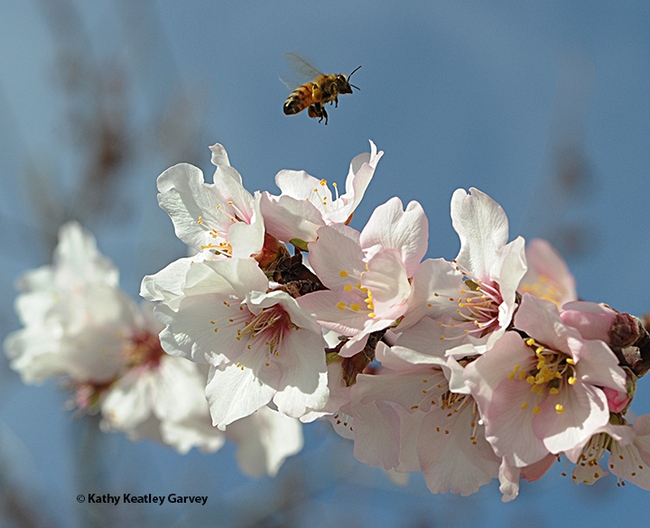
A honey bee buzzes over an almond branch on its way to pollinate another blossom. (Photo by Kathy Keatley Garvey)
Almond growers should prepare for possibility of unusual disease outbreak
Wet winter, El Niño create favorable conditions for aerial Phytophthora pathogen
With heavy rains in the forecast amid strengthening El Niño conditions, almond growers should be on the lookout for a rare disease that can cause severe damage to their orchards, according to Florent Trouillas, a University of California Cooperative Extension specialist in fruit and nut pathology.
Phytophthora, soilborne microorganisms dubbed “water molds” because of their dependence on water, typically cause root and crown rot at the base of trees. But a few aerial Phytophthora can travel upwards and infect the higher parts of the tree. One species – Phytophthora syringae – is drawing special attention due to an unprecedented outbreak last winter, fueled by the atmospheric rivers that lashed California.
“It was found statewide – meaning in every almond-producing county – and disease incidence in orchards ranged from 10% of the trees infected to 75%,” said Trouillas, a UC Davis plant pathologist whose lab is based at UC Agriculture and Natural Resources' Kearney Agricultural Research and Extension Center in Parlier.
Trouillas and his colleagues, UC Davis graduate student Alejandro Hernandez and UC Riverside plant pathology professor Jim Adaskaveg, recently published a detailed online article describing the pathogen, which can infect a range of crops but mainly impacts almonds in California.
Although it doesn't kill the tree, the disease causes branch dieback that requires significant additional work and expense for almond growers. In 2022, almonds were the state's fourth-highest valued commodity, at $3.52 billion.
During last year's aerial Phytophthora outbreak, researchers also observed a new and troubling phenomenon: P. syringae, historically known to attack the cuts caused by pruning, was directly infecting the young shoots on almond trees – without any wounds.
“This was really the first time we had seen widespread evidence of infection on the twigs,” Trouillas said.
Although generally rare, outbreaks of P. syringae have been traditionally associated with wet El Niño years, according to Trouillas – and recent and persistent rain across the state should have growers on high alert.
Prune in dry weather, monitor, mitigate if necessary
While almond growers tend to prune during the downtime of winter, they should keep an eye on the forecast and aim for a 10- to 14-day window of dry weather to perform those tasks, whether training young trees or maintaining the established ones.
“If growers were to prune around a rain event – before, during or shortly after – this increases the likelihood of infection because this pathogen moves around with water,” Trouillas explained.
Researchers speculate that P. syringae, normally found in the soil, gets carried into the upper parts of a tree through strong winds and heavy rain. Alternatively, harvest processes like shaking and sweeping also produce air movements that may blow the microorganism into the canopy, where it waits for a favorable wet environment. The pathogen then attacks the wounds or young shoots, producing characteristic cankers and gumming.
The patterns and colors of the gum balls are keys to diagnosing an infection of this particular aerial Phytophthora. Starting around bloom time (mid-February), growers should monitor pruning wounds and young shoots on their trees, especially in the canopy, for signs of the disease.
The unique coloration of the gum balls – ranging from gold and amber to dark burgundy to bright red (see photos) – generally indicates P. syringae infection. But growers are urged to contact their local Cooperative Extension advisor for confirmation.
“It is super critical for growers that, whenever they see gumming, not to assume that it is this aerial phytophthora, because there are many other diseases that can cause gumming on the tree,” Trouillas said.
If the diagnosis is confirmed, growers may apply a compound that can mitigate the infection. The plant pathologists' recent writeup describes several curative treatment options, as well as a preventive measure that reduces the amount of pathogen in the soil and thus the likelihood of infection.
For more information on the pathogen's history and biology, as well as various options for disease management, visit the article on Sacramento Valley Orchard Source: https://www.sacvalleyorchards.com/almonds/trunk-soil-diseases/aerial-phytophthora-outbreaks-in-wet-years.
Arnon Dag: How to Improve Cross-Pollination in Almond, Pear, Apple and Cherry Trees
How can you improve cross-pollination in such tree crops as almond, pear, apple and cherry? Senior scientist Arnon Dag of the Agricultural Research Organization, Volcani Institute, Israel, will discuss his research at the UC Davis Department of Entomology...
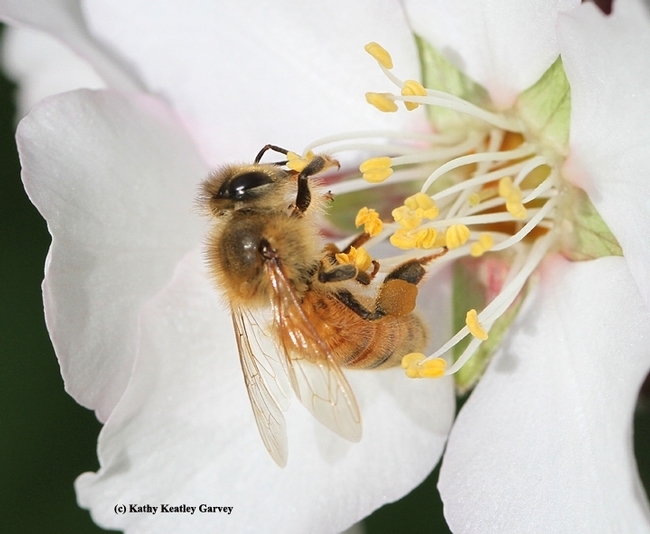
A honey bee pollinating an almond blossom. (Photo by Kathy Keatley Garvey)
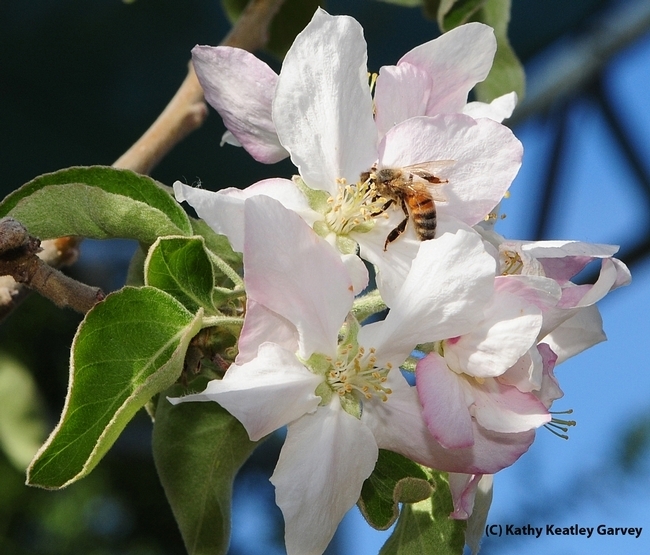
A honey bee pollinating an apple blossom. (Photo by Kathy Keatley Garvey)
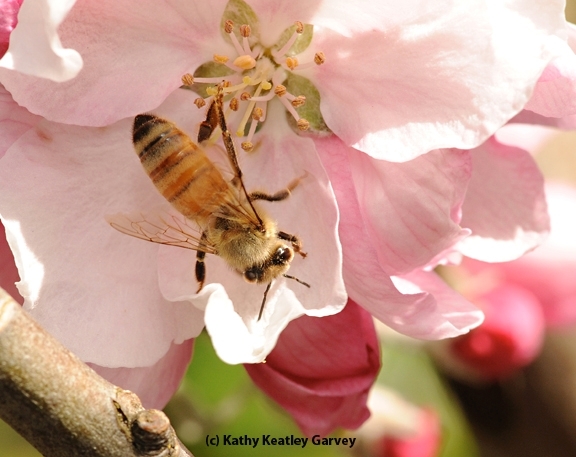
A honey bee pollinating a cherry blossom. (Photo by Kathy Keatley Garvey)
Tree and vine fall weed management
The 2023 post-harvest season is upon us and it's time to prep for your fall/winter weed control activities. The long-range forecast is calling for another wet winter, and November is the ideal time to plan your early winter weed control program, to check that your spray equipment is functioning...

